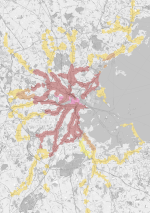Delvin4519
Active Member
- Joined
- Oct 8, 2022
- Messages
- 884
- Reaction score
- 1,536
I wonder, under such an alternate history timeline where the Highland Branch were to be abandoned for several years (or a decade or so), would a hookup with the Green Line still have happened, or would reproposals decades later to reactivate the Highland Branch have kept it separated from the Green Line?Fairly high since the line is fully grade separated and hits the center(s) of Newton. I suspect the line might have gone to Needham rather than Riverside though.
The Highland Branch reopened in 1959 as the Green Line D branch after just over a year of conversion, and 10 years later a shortage of vehicles caused the closure of the A branch in 1969, which had previously served much more densely populated urban areas unlike the Highland Branch.
I would be curious under an alternate timeline where the Highland Branch had been outright abandoned in 1958, or had lasted an additional 10 years into the 1960s, if there would have been opposition to restoring the Highland Branch as an additional Green Line branch. By the late 1960s, the MBTA did not have enough Green Line cars to add an extra branch to the GL. In such a case, the T would have had needed to decide whether to sacrifice an existing urban Green Line branch for a new branch on previously commuter rail tracks, abandon plans to restore the Highland Branch, or restore the Highland Branch as something else.
Last edited:

